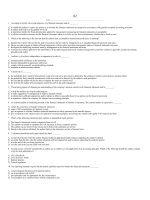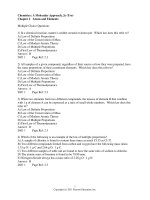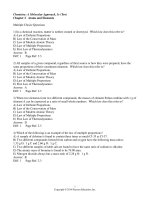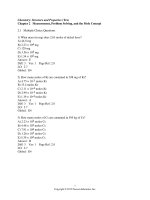Introductory chemistry an atoms first approach 1st edition burdge test bank
Bạn đang xem bản rút gọn của tài liệu. Xem và tải ngay bản đầy đủ của tài liệu tại đây (338.23 KB, 33 trang )
1. Visible light, radio waves, microwave radiation, infrared, ultraviolet radiation, X-rays, and gamma rays all constitute
the electromagnetic spectrum. Which of the following characteristics do all of these kinds of radiation share?
A. They all have the ability to generate heat in objects.
B. They all have the same frequencies.
C. They are all the transmission of energy in the form of waves.
D. They have equal energies.
E. They have the same electron spin state.
Accessibility: Keyboard Navigation
Bloom's Level: 3. Apply
Difficulty: Medium
Gradable: automatic
Subtopic: Electromagnetic Radiation (Wave Properties)
Topic: Quantum Theory and Atomic Structure
2. Select the arrangement of electromagnetic radiation which starts with the shortest wavelength and increases to longest
wavelength.
A. radio, infrared, ultraviolet, gamma rays
B. radio, ultraviolet, infrared, gamma rays
C. gamma rays, radio, ultraviolet, infrared
D. gamma rays, infrared, radio, ultraviolet
E. gamma rays, ultraviolet, infrared, radio
Accessibility: Keyboard Navigation
Bloom's Level: 5. Evaluate
Difficulty: Hard
Gradable: automatic
Subtopic: Electromagnetic Radiation (Wave Properties)
Subtopic: Measurement (SI Units)
Subtopic: Scientific Notation and Significant Figures
Topic: Quantum Theory and Atomic Structure
3. Select the arrangement of electromagnetic radiation which starts with the lowest energy and increases to the greatest
energy.
A. radio, infrared, ultraviolet, gamma rays
radio, ultraviolet, infrared, gamma rays
gamma rays, infrared, radio, ultraviolet
gamma rays, ultraviolet, infrared, radio
infrared, ultraviolet, radio, gamma rays
Accessibility: Keyboard Navigation
Bloom's Level: 5. Evaluate
Difficulty: Hard
Gradable: automatic
Subtopic: Electromagnetic Radiation (Wave Properties)
Topic: Quantum Theory and Atomic Structure
2-1
Copyright © 2016 McGraw-Hill Education. All rights reserved. No reproduction or distribution without the prior written consent of McGraw-Hill Education.
4. What is the emission of light at only specific wavelengths?
A. Emission spectra
B. Hydrogen spectrum
C. Wave spectra
D. Limited spectra
E. Line spectra
Accessibility: Keyboard Navigation
Bloom's Level: 2. Understand
Difficulty: Easy
Gradable: automatic
Subtopic: Atomic Spectra (Bohr Model of the Atom)
Subtopic: Electromagnetic Radiation (Wave Properties)
Subtopic: Measurement (SI Units)
Subtopic: Scientific Notation and Significant Figures
Topic: Quantum Theory and Atomic Structure
5. List the following types of radiation from lowest frequency to highest frequency: microwave, X ray, ultraviolet,
visible, and infrared
A. microwave < infrared < visible < ultraviolet < X ray
B. X ray < ultraviolet < visible < infrared < microwave
C.visible < ultraviolet < microwave < X ray < infrared
D. infrared < X ray < microwave < ultraviolet < visible
E. infrared < visible < microwave < ultraviolet < X ray
Accessibility: Keyboard Navigation
Bloom's Level: 5. Evaluate
Difficulty: Easy
Gradable: automatic
Subtopic: Electromagnetic Radiation (Wave Properties)
Topic: Quantum Theory and Atomic Structure
6. Which of the following electron transitions would be expected to emit any light in the Bohr model of the atom?
A. n = 1 to n = 3
B. n = 5 to n = 6
C. n = 2 to n = 5
D. n = 4 to n = 3
Accessibility: Keyboard Navigation
Bloom's Level: 2. Understand
Difficulty: Easy
Gradable: automatic
Subtopic: Atomic Spectra (Bohr Model of the Atom)
Topic: Quantum Theory and Atomic Structure
2-2
Copyright © 2016 McGraw-Hill Education. All rights reserved. No reproduction or distribution without the prior written consent of McGraw-Hill Education.
7. Which of the following electron transitions would be expected to emit any light in the Bohr model of the atom?
A. n = 1 to n = 4
B. n = 3 to n = 1
C. n = 2 to n = 3
D. n = 5 to n = 7
Accessibility: Keyboard Navigation
Bloom's Level: 2. Understand
Difficulty: Easy
Gradable: automatic
Subtopic: Atomic Spectra (Bohr Model of the Atom)
Topic: Quantum Theory and Atomic Structure
8. Which of the following electron transitions would be expected to absorb any light in the Bohr model of the atom?
A. n = 1 to n = 3
B. n = 3 to n = 2
C. n = 4 to n = 2
D. n = 6 to n = 5
Accessibility: Keyboard Navigation
Bloom's Level: 2. Understand
Difficulty: Easy
Gradable: automatic
Subtopic: Atomic Spectra (Bohr Model of the Atom)
Topic: Quantum Theory and Atomic Structure
9. Which of the following electron transitions would be expected to absorb any light in the Bohr model of the atom?
A. n = 7 to n = 2
B. n = 5 to n = 6
C. n = 1 to n = 3
D. n = 3 to n = 5
Accessibility: Keyboard Navigation
Bloom's Level: 2. Understand
Difficulty: Easy
Gradable: automatic
Subtopic: Atomic Spectra (Bohr Model of the Atom)
Topic: Quantum Theory and Atomic Structure
10. The size of an atomic orbital is associated with
A. the principal quantum number (n).
B. the angular momentum quantum number (l).
C. the magnetic quantum number (ml).
D. the spin quantum number (ms).
E. the angular momentum and magnetic quantum numbers, together.
Accessibility: Keyboard Navigation
Bloom's Level: 2. Understand
Difficulty: Easy
Gradable: automatic
Subtopic: Atomic Theories
Subtopic: Quantum Numbers
Topic: Components of Matter
Topic: Quantum Theory and Atomic Structure
2-3
Copyright © 2016 McGraw-Hill Education. All rights reserved. No reproduction or distribution without the prior written consent of McGraw-Hill Education.
11. Atomic orbitals developed using quantum mechanics
A. describe regions of space in which one is most likely to find an electron.
B. describe exact paths for electron motion.
C. give a description of the atomic structure which is essentially the same as the Bohr model.
E. allow scientists to calculate an exact volume for the hydrogen atom.
F. are in conflict with the Heisenberg uncertainty principle.
Accessibility: Keyboard Navigation
Bloom's Level: 3. Apply
Difficulty: Medium
Gradable: automatic
Subtopic: Atomic Theories
Subtopic: Quantum Numbers
Topic: Components of Matter
Topic: Quantum Theory and Atomic Structure
12. The number of orbitals in a d subshell is
A. 1.
B. 2.
C. 3.
D. 5.
E. 7.
Accessibility: Keyboard Navigation
Bloom's Level: 4. Analyze
Difficulty: Easy
Gradable: automatic
Subtopic: Assigning Electrons to Atomic Orbitals (Aufbau Principle)
Subtopic: Quantum Numbers
Topic: Electron Configuration
Topic: Quantum Theory and Atomic Structure
13. How many orbitals can have the 3p description in a given atom?
A. 1
B. 2
C. 3
D. 5
Accessibility: Keyboard Navigation
Bloom's Level: 2. Understand
Difficulty: Easy
Gradable: automatic
Subtopic: Quantum Numbers
Topic: Quantum Theory and Atomic Structure
14. How many orbitals can have the 3d description in a given atom?
A. 1
B. 2
C. 3
D. 5
Accessibility: Keyboard Navigation
Bloom's Level: 2. Understand
Difficulty: Easy
Gradable: automatic
Subtopic: Quantum Numbers
Topic: Quantum Theory and Atomic Structure
2-4
Copyright © 2016 McGraw-Hill Education. All rights reserved. No reproduction or distribution without the prior written consent of McGraw-Hill Education.
15. How many orbitals can have the 4s description in a given atom?
A. 1
B. 2
C. 3
D. 5
Accessibility: Keyboard Navigation
Bloom's Level: 2. Understand
Difficulty: Easy
Gradable: automatic
Subtopic: Quantum Numbers
Topic: Quantum Theory and Atomic Structure
16. How many orbitals can have the 4p description in a given atom?
A. 1
B. 2
C. 3
D. 4
Accessibility: Keyboard Navigation
Bloom's Level: 2. Understand
Difficulty: Easy
Gradable: automatic
Subtopic: Quantum Numbers
Topic: Quantum Theory and Atomic Structure
17. Determine which sublevel designation is legitimate.
A. 1f
B. 2d
C. 3c
D. 4s
Accessibility: Keyboard Navigation
Bloom's Level: 2. Understand
Difficulty: Easy
Gradable: automatic
Subtopic: Quantum Numbers
Topic: Quantum Theory and Atomic Structure
18. Determine which sublevel designation is legitimate.
A. 1p
B. 2p
C. 3f
D. 4z
Accessibility: Keyboard Navigation
Bloom's Level: 2. Understand
Difficulty: Easy
Gradable: automatic
Subtopic: Quantum Numbers
Topic: Quantum Theory and Atomic Structure
2-5
Copyright © 2016 McGraw-Hill Education. All rights reserved. No reproduction or distribution without the prior written consent of McGraw-Hill Education.
19. Determine which sublevel designation is not legitimate.
A. 1p
B. 2s
C. 3d
D. 4p
Accessibility: Keyboard Navigation
Bloom's Level: 2. Understand
Difficulty: Easy
Gradable: automatic
Subtopic: Quantum Numbers
Topic: Quantum Theory and Atomic Structure
20. Determine which sublevel designation is not legitimate.
A. 4s
B. 2d
C. 3s
D. 5p
Accessibility: Keyboard Navigation
Bloom's Level: 2. Understand
Difficulty: Easy
Gradable: automatic
Subtopic: Quantum Numbers
Topic: Quantum Theory and Atomic Structure
21. How many orbitals are there in the n = 4 level of the H-atom?
A. 4
B. 6
C. 8
D. 16
E. 18
Accessibility: Keyboard Navigation
Bloom's Level: 3. Apply
Difficulty: Hard
Gradable: automatic
Subtopic: Assigning Electrons to Atomic Orbitals (Aufbau Principle)
Subtopic: Quantum Numbers
Topic: Electron Configuration
Topic: Quantum Theory and Atomic Structure
22. Each shell (principal energy level) of quantum number n contains n subshells.
TRUE
Accessibility: Keyboard Navigation
Bloom's Level: 2. Understand
Difficulty: Medium
Gradable: automatic
Subtopic: Quantum Numbers
Topic: Quantum Theory and Atomic Structure
23. For all atoms of the same element, the 2s orbital is larger than the 1s orbital.
TRUE
Accessibility: Keyboard Navigation
Bloom's Level: 3. Apply
Difficulty: Easy
Gradable: automatic
Subtopic: Quantum Numbers
Topic: Quantum Theory and Atomic Structure
2-6
Copyright © 2016 McGraw-Hill Education. All rights reserved. No reproduction or distribution without the prior written consent of McGraw-Hill Education.
24. The orbital diagram for a ground-state nitrogen atom is
1s
2s
2p
↿⇂
↿⇂
↿
↿
↿
A
↿⇂
↿
↿⇂
↿
B
↿⇂
↿⇂
↿⇂
↿
C
↿⇂
↿⇂
↿⇂
↿
↿
D
↿⇂
↿⇂
↿⇂
↿⇂
↿
E
A. A
B. B
C. C
D. D
E. E
Bloom's Level: 4. Analyze
Difficulty: Easy
Gradable: automatic
Subtopic: Assigning Electrons to Atomic Orbitals (Aufbau Principle)
Subtopic: Quantum Numbers
Topic: Electron Configuration
Topic: Quantum Theory and Atomic Structure
25. The orbital diagram for a ground-state oxygen atom is
1s
2s
2p
↿⇂
↿⇂
↿
↿
↿
A
↿⇂
↿⇂
↿⇂
↿⇂
B
↿⇂
↿⇂
↿⇂
↿
C
↿⇂
↿⇂
↿⇂
↿
↿
D
↿⇂
↿⇂
↿⇂
↿⇂
↿
E
A. A
B. B
C. C
D. D
E. E
Bloom's Level: 4. Analyze
Difficulty: Easy
Gradable: automatic
Subtopic: Assigning Electrons to Atomic Orbitals (Aufbau Principle)
Subtopic: Quantum Numbers
Topic: Electron Configuration
Topic: Quantum Theory and Atomic Structure
2-7
Copyright © 2016 McGraw-Hill Education. All rights reserved. No reproduction or distribution without the prior written consent of McGraw-Hill Education.
26. The orbital diagram for a ground-state carbon atom is
1s
2s
2p
↿⇂
↿⇂
↿⇂
A
↿⇂
↿
↿
↿
↿
B
↿⇂
↿⇂
↿
↿
↿
C
↿⇂
↿⇂
↿
↿
D
↿⇂
↿⇂
↿⇂
↿⇂
↿
E
A. A
B. B
C. C
D. D
E. E
Bloom's Level: 4. Analyze
Difficulty: Easy
Gradable: automatic
Subtopic: Assigning Electrons to Atomic Orbitals (Aufbau Principle)
Subtopic: Quantum Numbers
Topic: Electron Configuration
Topic: Quantum Theory and Atomic Structure
27. Which ground-state atom has an electron configuration described by the following orbital diagram?
[Ar] ↿⇂
4s
↿⇂ ↿⇂ ↿⇂ ↿⇂ ↿⇂
3d
↿⇂ ↿ ↿
4p
A. phosphorus
B. germanium
C. selenium
D. tellurium
E. potassium
Bloom's Level: 4. Analyze
Difficulty: Easy
Gradable: automatic
Subtopic: Assigning Electrons to Atomic Orbitals (Aufbau Principle)
Subtopic: Quantum Numbers
Topic: Electron Configuration
Topic: Quantum Theory and Atomic Structure
28. Which ground-state atom has an electron configuration described by the following orbital diagram?
[Ne]↿⇂
↿ ↿↿
3s
3p
A. phosphorus
B. nitrogen
C. arsenic
D. vanadium
E. sulfur
Bloom's Level: 4. Analyze
Difficulty: Easy
Gradable: automatic
Subtopic: Assigning Electrons to Atomic Orbitals (Aufbau Principle)
Subtopic: Quantum Numbers
Topic: Electron Configuration
Topic: Quantum Theory and Atomic Structure
2-8
Copyright © 2016 McGraw-Hill Education. All rights reserved. No reproduction or distribution without the prior written consent of McGraw-Hill Education.
29. How many unpaired electrons does a ground-state atom of sulfur have?
A. 0
B. 1
C. 2
D. 3
E. 4
Accessibility: Keyboard Navigation
Bloom's Level: 4. Analyze
Difficulty: Medium
Gradable: automatic
Subtopic: Assigning Electrons to Atomic Orbitals (Aufbau Principle)
Subtopic: Pauli Exclusion Principle
Subtopic: Quantum Numbers
Topic: Electron Configuration
Topic: Quantum Theory and Atomic Structure
30. Which element has the following ground-state electron configuration? 1s2 2s2 2p6 3s2
Na
Mg
Al
Si
Ne
Accessibility: Keyboard Navigation
Bloom's Level: 4. Analyze
Difficulty: Easy
Gradable: automatic
Subtopic: Assigning Electrons to Atomic Orbitals (Aufbau Principle)
Subtopic: Energy-Level Splitting (Zeff and Shielding)
Subtopic: Hund's Rule
Subtopic: Quantum Numbers
Topic: Electron Configuration
Topic: Quantum Theory and Atomic Structure
31. Which element has the following ground-state electron configuration?
[Kr]5s24d105p3
A. Sn
B. Sb
C. Pb
D. Bi
E. Te
Accessibility: Keyboard Navigation
Bloom's Level: 4. Analyze
Difficulty: Easy
Gradable: automatic
Subtopic: Assigning Electrons to Atomic Orbitals (Aufbau Principle)
Subtopic: Energy-Level Splitting (Zeff and Shielding)
Subtopic: Quantum Numbers
Topic: Electron Configuration
Topic: Quantum Theory and Atomic Structure
2-9
Copyright © 2016 McGraw-Hill Education. All rights reserved. No reproduction or distribution without the prior written consent of McGraw-Hill Education.
32. Which element has the following ground-state electron configuration?
[Kr]5s24d105p2
A. Sn
B. Sb
C. Pb
D. Ge
E. Te
Accessibility: Keyboard Navigation
Bloom's Level: 4. Analyze
Difficulty: Easy
Gradable: automatic
Subtopic: Assigning Electrons to Atomic Orbitals (Aufbau Principle)
Subtopic: Energy-Level Splitting (Zeff and Shielding)
Subtopic: Quantum Numbers
Topic: Electron Configuration
Topic: Quantum Theory and Atomic Structure
33. The electron configuration of a ground-state Co atom is
A. [Ar]4s23d7
B. 1s22s22p63s23d9
C. [Ne]3s23d7
D. [Ar]4s13d5
E. [Ar]4s24d7
Accessibility: Keyboard Navigation
Bloom's Level: 4. Analyze
Difficulty: Medium
Gradable: automatic
Subtopic: Assigning Electrons to Atomic Orbitals (Aufbau Principle)
Subtopic: Energy-Level Splitting (Zeff and Shielding)
Subtopic: Quantum Numbers
Topic: Electron Configuration
Topic: Quantum Theory and Atomic Structure
34. The electron configuration of a ground-state vanadium atom is
A. [Ar]4s24d3
B. [Ar]4s24p3
C. [Ar]4s23d3
D. [Ar]3d5
E. [Ar]4s23d7
Accessibility: Keyboard Navigation
Bloom's Level: 4. Analyze
Difficulty: Medium
Gradable: automatic
Subtopic: Assigning Electrons to Atomic Orbitals (Aufbau Principle)
Subtopic: Energy-Level Splitting (Zeff and Shielding)
Subtopic: Quantum Numbers
Topic: Electron Configuration
Topic: Quantum Theory and Atomic Structure
2-10
Copyright © 2016 McGraw-Hill Education. All rights reserved. No reproduction or distribution without the prior written consent of McGraw-Hill Education.
35. The ground-state electron configuration for an atom of indium is
A. [Kr]5s24p64d5
B. [Ar]4s23d104p1
C. [Ar]4s24p63d5
D. [Kr]5s25p64d5
E. [Kr]5s24d105p1
Accessibility: Keyboard Navigation
Bloom's Level: 4. Analyze
Difficulty: Medium
Gradable: automatic
Subtopic: Assigning Electrons to Atomic Orbitals (Aufbau Principle)
Subtopic: Energy-Level Splitting (Zeff and Shielding)
Subtopic: Quantum Numbers
Topic: Electron Configuration
Topic: Quantum Theory and Atomic Structure
36. The ground-state electron configuration of a calcium atom is
A. [Ne]3s2
B. [Ne]3s23p6
C. [Ar]4s13d1
D. [Ar]4s2
E. [Ar]3d2
Accessibility: Keyboard Navigation
Bloom's Level: 4. Analyze
Difficulty: Easy
Gradable: automatic
Subtopic: Assigning Electrons to Atomic Orbitals (Aufbau Principle)
Subtopic: Energy-Level Splitting (Zeff and Shielding)
Subtopic: Quantum Numbers
Topic: Electron Configuration
Topic: Quantum Theory and Atomic Structure
37. Select the correct electron configuration for sulfur (Z = 16).
A. 1s21p62s22p6
B. 1s22s22p83s23p4
C. 1s22s22p83s23p2
D. 1s22s22p63s23p4
E. 1s22s22p63s23d4
Accessibility: Keyboard Navigation
Bloom's Level: 4. Analyze
Difficulty: Easy
Gradable: automatic
Subtopic: Assigning Electrons to Atomic Orbitals (Aufbau Principle)
Subtopic: Quantum Numbers
Topic: Electron Configuration
Topic: Quantum Theory and Atomic Structure
38. Select the correct electron configuration for Te (Z = 52).
A. [Kr]5s25p64d8
B. [Kr]5s25d105p4
C. [Kr]5s24d105p6
D. [Kr]5s24f14
E. [Kr]5s24d105p4
Accessibility: Keyboard Navigation
Bloom's Level: 4. Analyze
Difficulty: Medium
Gradable: automatic
Subtopic: Assigning Electrons to Atomic Orbitals (Aufbau Principle)
Subtopic: Energy-Level Splitting (Zeff and Shielding)
Subtopic: Quantum Numbers
Topic: Electron Configuration
Topic: Quantum Theory and Atomic Structure
2-11
Copyright © 2016 McGraw-Hill Education. All rights reserved. No reproduction or distribution without the prior written consent of McGraw-Hill Education.
39. What is the correct electron configuration for a germanium (Ge) atom?
A. 1s22s22p63s23p64s24p2
B. 1s22s22p63s23p64s23d104p2
C. 1s22s22p63s23p2
D. 1s22s23s23p5
E. None of the answers is correct.
Accessibility: Keyboard Navigation
Bloom's Level: 4. Analyze
Difficulty: Medium
Gradable: automatic
Subtopic: Assigning Electrons to Atomic Orbitals (Aufbau Principle)
Subtopic: Energy-Level Splitting (Zeff and Shielding)
Subtopic: Quantum Numbers
Topic: Electron Configuration
Topic: Quantum Theory and Atomic Structure
40. The electronic structure 1s22s22p63s23p64s23d8 refers to the ground state of
A. Kr.
B. Ni.
C. Fe.
D. Pd.
E. None of these choices is correct.
Accessibility: Keyboard Navigation
Bloom's Level: 4. Analyze
Difficulty: Medium
Gradable: automatic
Subtopic: Assigning Electrons to Atomic Orbitals (Aufbau Principle)
Subtopic: Energy-Level Splitting (Zeff and Shielding)
Subtopic: Quantum Numbers
Topic: Electron Configuration
Topic: Quantum Theory and Atomic Structure
41. How many electrons are in the 4p orbitals of selenium?
A. 0
B. 2
C. 4
D. 5
E. 6
Accessibility: Keyboard Navigation
Bloom's Level: 4. Analyze
Difficulty: Medium
Gradable: automatic
Subtopic: Assigning Electrons to Atomic Orbitals (Aufbau Principle)
Subtopic: Quantum Numbers
Topic: Electron Configuration
Topic: Quantum Theory and Atomic Structure
42. How many electrons are in the 4p orbitals of vanadium?
A. 0
B. 2
C. 4
D. 5
E. 6
Accessibility: Keyboard Navigation
Bloom's Level: 4. Analyze
Difficulty: Medium
Gradable: automatic
Subtopic: Assigning Electrons to Atomic Orbitals (Aufbau Principle)
Subtopic: Quantum Numbers
Topic: Electron Configuration
Topic: Quantum Theory and Atomic Structure
2-12
Copyright © 2016 McGraw-Hill Education. All rights reserved. No reproduction or distribution without the prior written consent of McGraw-Hill Education.
43. How many electrons are in the 4d orbitals of Tc?
A. 1
B. 2
C. 3
D. 4
E. 5
Accessibility: Keyboard Navigation
Bloom's Level: 4. Analyze
Difficulty: Medium
Gradable: automatic
Subtopic: Assigning Electrons to Atomic Orbitals (Aufbau Principle)
Subtopic: Quantum Numbers
Topic: Electron Configuration
Topic: Quantum Theory and Atomic Structure
44. How many electrons are there in the 2nd principal energy level (n = 2) of a phosphorus atom?
A. 3
B. 5
C. 6
D. 8
E. 10
Accessibility: Keyboard Navigation
Bloom's Level: 4. Analyze
Difficulty: Medium
Gradable: automatic
Subtopic: Assigning Electrons to Atomic Orbitals (Aufbau Principle)
Subtopic: Quantum Numbers
Topic: Electron Configuration
Topic: Quantum Theory and Atomic Structure
45. How many electrons are there in the 3rd principal energy level (n = 3) of a phosphorus atom?
A. 3
B. 5
C. 6
D. 8
E. 10
Accessibility: Keyboard Navigation
Bloom's Level: 4. Analyze
Difficulty: Medium
Gradable: automatic
Subtopic: Assigning Electrons to Atomic Orbitals (Aufbau Principle)
Subtopic: Quantum Numbers
Topic: Electron Configuration
Topic: Quantum Theory and Atomic Structure
46. What element is represented by the electron configuration 1s22s22p63s23p64s13d5?
Mn
Ca
K
Cr
V
Accessibility: Keyboard Navigation
Bloom's Level: 4. Analyze
Difficulty: Medium
Gradable: automatic
Subtopic: Assigning Electrons to Atomic Orbitals (Aufbau Principle)
Subtopic: Energy-Level Splitting (Zeff and Shielding)
Subtopic: Quantum Numbers
Topic: Electron Configuration
Topic: Quantum Theory and Atomic Structure
2-13
Copyright © 2016 McGraw-Hill Education. All rights reserved. No reproduction or distribution without the prior written consent of McGraw-Hill Education.
47. What element is represented by the electron configuration 1s22s22p63s23p64s23d104p65s14d10?
A. Ag
B. Rb
C. Cd
D. Sr
E. Cu
Accessibility: Keyboard Navigation
Bloom's Level: 4. Analyze
Difficulty: Medium
Gradable: automatic
Subtopic: Assigning Electrons to Atomic Orbitals (Aufbau Principle)
Subtopic: Energy-Level Splitting (Zeff and Shielding)
Subtopic: Quantum Numbers
Topic: Electron Configuration
Topic: Quantum Theory and Atomic Structure
48. What is the electron configuration for tungsten?
A. 1s22s22p63s23p64s23d104p65s24d105p66s24f145d6
B. 1s22s22p63s23p64s23d104p65s24d105p66s14f145d5
C. 1s22s22p63s23p64s23d104p65s24d105p66s24f145d4
D. 1s22s22p63s23p64s23d104p65s24d105p66s24f145d7
E. 1s22s22p63s23p54s23d104p65s24d105p66s24f145d7
Accessibility: Keyboard Navigation
Bloom's Level: 4. Analyze
Difficulty: Medium
Gradable: automatic
Subtopic: Assigning Electrons to Atomic Orbitals (Aufbau Principle)
Subtopic: Quantum Numbers
Topic: Electron Configuration
Topic: Quantum Theory and Atomic Structure
49. What is the electron configuration for silicon?
A. 1s22s22p63s13p3
B.1s22s22p63s23p2
C. 1s22s22p63s4
D. 1s22s22p63p4
E. 1s22s22p63s23p3
Accessibility: Keyboard Navigation
Bloom's Level: 4. Analyze
Difficulty: Easy
Gradable: automatic
Subtopic: Assigning Electrons to Atomic Orbitals (Aufbau Principle)
Subtopic: Quantum Numbers
Topic: Electron Configuration
Topic: Quantum Theory and Atomic Structure
2-14
Copyright © 2016 McGraw-Hill Education. All rights reserved. No reproduction or distribution without the prior written consent of McGraw-Hill Education.
50. What is the electron configuration for bromine?
A. 1s22s22p63s23p64s14d104p6
B. 1s22s22p63s23p64s24d104p5
C. 1s22s22p63s23p64s13d104p6
D. 1s22s22p63s23p64s23d104p4
E. 1s22s22p63s23p64s23d104p5
Accessibility: Keyboard Navigation
Bloom's Level: 4. Analyze
Difficulty: Medium
Gradable: automatic
Subtopic: Assigning Electrons to Atomic Orbitals (Aufbau Principle)
Subtopic: Energy-Level Splitting (Zeff and Shielding)
Subtopic: Quantum Numbers
Topic: Electron Configuration
Topic: Quantum Theory and Atomic Structure
51. Which of the following elements has the largest number of unpaired electrons in the ground state?
A. K
B. V
C. S
D. Si
E. Cl
Accessibility: Keyboard Navigation
Bloom's Level: 4. Analyze
Difficulty: Hard
Gradable: automatic
Subtopic: Assigning Electrons to Atomic Orbitals (Aufbau Principle)
Subtopic: Diamagnetism and Paramagnetism
Subtopic: Energy-Level Splitting (Zeff and Shielding)
Subtopic: Hund's Rule
Subtopic: Quantum Numbers
Topic: Electron Configuration
Topic: Quantum Theory and Atomic Structure
52. The general electron configuration for atoms of all elements in Group 5A is
A. ns2np6.
B. ns2np5.
C. ns2np4.
D. ns2np3.
E. ns2np1.
Accessibility: Keyboard Navigation
Bloom's Level: 3. Apply
Difficulty: Easy
Gradable: automatic
Subtopic: Elements and the Periodic Table
Subtopic: Periodic Classification of the Elements
Topic: Chemical Periodicity
Topic: Components of Matter
2-15
Copyright © 2016 McGraw-Hill Education. All rights reserved. No reproduction or distribution without the prior written consent of McGraw-Hill Education.
53. Which of these choices is the general electron configuration for the outermost electrons of elements in the
alkaline earth group?
A. ns1
B. ns2
C. ns2np4
D. ns2np
E. ns2np6 (n − 1)d6
Accessibility: Keyboard Navigation
Bloom's Level: 3. Apply
Difficulty: Medium
Gradable: automatic
Subtopic: Assigning Electrons to Atomic Orbitals (Aufbau Principle)
Subtopic: Periodic Classification of the Elements
Topic: Chemical Periodicity
Topic: Electron Configuration
54. The general electron configuration for atoms of the halogen group is
A. ns2np6.
B. ns2np5.
C. ns2np6 (n − 1)d7.
D. ns1.
E. ns2np7.
Accessibility: Keyboard Navigation
Bloom's Level: 3. Apply
Difficulty: Easy
Gradable: automatic
Subtopic: Assigning Electrons to Atomic Orbitals (Aufbau Principle)
Subtopic: Periodic Classification of the Elements
Topic: Chemical Periodicity
Topic: Electron Configuration
55. The general electron configuration for noble gas atoms is
A. ns2np6.
B. ns2np5.
C. ns2np4.
D. ns2np3.
E. ns2.
Accessibility: Keyboard Navigation
Bloom's Level: 3. Apply
Difficulty: Easy
Gradable: automatic
Subtopic: Assigning Electrons to Atomic Orbitals (Aufbau Principle)
Subtopic: Periodic Classification of the Elements
Topic: Chemical Periodicity
Topic: Electron Configuration
56. Each of the noble gases has a completely filled p subshell except for which one?
A. Xenon
B. Neon
C. Radon
D. Argon
E. Helium
Accessibility: Keyboard Navigation
Bloom's Level: 5. Evaluate
Difficulty: Medium
Gradable: automatic
Subtopic: Assigning Electrons to Atomic Orbitals (Aufbau Principle)
Subtopic: Periodic Classification of the Elements
Topic: Chemical Periodicity
Topic: Electron Configuration
2-16
Copyright © 2016 McGraw-Hill Education. All rights reserved. No reproduction or distribution without the prior written consent of McGraw-Hill Education.
57. An element with the general electron configuration for its outermost electrons of ns2np1 would be in which
element group?
A. 2A
B. 3A
C. 4A
D. 5A
E. 8A
Accessibility: Keyboard Navigation
Bloom's Level: 4. Analyze
Difficulty: Easy
Gradable: automatic
Subtopic: Assigning Electrons to Atomic Orbitals (Aufbau Principle)
Subtopic: Periodic Classification of the Elements
Topic: Chemical Periodicity
Topic: Electron Configuration
58. In what group of the periodic table is the element with the electron configuration [Ar]4s23d104p3?
A. 1A
B. 2A
C. 3A
D. 4A
E. 5A
Accessibility: Keyboard Navigation
Bloom's Level: 4. Analyze
Difficulty: Medium
Gradable: automatic
Subtopic: Assigning Electrons to Atomic Orbitals (Aufbau Principle)
Subtopic: Periodic Classification of the Elements
Topic: Chemical Periodicity
Topic: Electron Configuration
59. Consider the element with the electron configuration [Kr]5s24d7. This element is
A. a halogen.
B. a transition metal.
C. a nonmetal.
D. an actinide element.
E. a noble gas.
Accessibility: Keyboard Navigation
Bloom's Level: 4. Analyze
Difficulty: Medium
Gradable: automatic
Subtopic: Assigning Electrons to Atomic Orbitals (Aufbau Principle)
Subtopic: Periodic Classification of the Elements
Subtopic: Properties of Transition Metals
Topic: Chemical Periodicity
Topic: Electron Configuration
Topic: Transition Metals and Coordination Compounds
2-17
Copyright © 2016 McGraw-Hill Education. All rights reserved. No reproduction or distribution without the prior written consent of McGraw-Hill Education.
60. Consider the element with the electron configuration [Kr]5s24d105p5. This element is
A. a halogen.
B. a transition metal.
C. an alkali metal.
D. an actinide element.
E. a noble gas.
Accessibility: Keyboard Navigation
Bloom's Level: 4. Analyze
Difficulty: Medium
Gradable: automatic
Subtopic: Assigning Electrons to Atomic Orbitals (Aufbau Principle)
Subtopic: Periodic Classification of the Elements
Topic: Chemical Periodicity
Topic: Electron Configuration
61. Consider the element with the electron configuration [Xe]6s24f7. This element is
A. a halogen.
B. a lanthanide element.
C. a nonmetal.
D. an actinide element.
E. a noble gas.
Accessibility: Keyboard Navigation
Bloom's Level: 4. Analyze
Difficulty: Medium
Gradable: automatic
Subtopic: Assigning Electrons to Atomic Orbitals (Aufbau Principle)
Subtopic: Periodic Classification of the Elements
Topic: Chemical Periodicity
Topic: Electron Configuration
62. How many valence electrons does a carbon atom have?
A. 1
B. 2
C. 3
D. 4
E. 6
Accessibility: Keyboard Navigation
Bloom's Level: 4. Analyze
Difficulty: Easy
Gradable: automatic
Subtopic: Assigning Electrons to Atomic Orbitals (Aufbau Principle)
Subtopic: Periodic Classification of the Elements
Topic: Chemical Periodicity
Topic: Electron Configuration
63. How many valence electrons does a tin (Sn) atom have?
A. 2
B. 4
C. 14
D. 36
E. 50
Accessibility: Keyboard Navigation
Bloom's Level: 4. Analyze
Difficulty: Medium
Gradable: automatic
Subtopic: Assigning Electrons to Atomic Orbitals (Aufbau Principle)
Subtopic: Periodic Classification of the Elements
Topic: Chemical Periodicity
Topic: Electron Configuration
2-18
Copyright © 2016 McGraw-Hill Education. All rights reserved. No reproduction or distribution without the prior written consent of McGraw-Hill Education.
64. An element with the electron configuration [noble gas]ns2(n − 1)d8 has ___________ valence electrons.
A. 2
B. 6
C. 8
D. 10
E. None of these choices is correct.
Accessibility: Keyboard Navigation
Bloom's Level: 4. Analyze
Difficulty: Medium
Gradable: automatic
Subtopic: Assigning Electrons to Atomic Orbitals (Aufbau Principle)
Subtopic: Periodic Classification of the Elements
Topic: Chemical Periodicity
Topic: Electron Configuration
65. An element with the electron configuration [noble gas]ns2(n − 1)d10np3 has ____________
valence electrons.
A. 2
B. 3
C. 5
D. 10
E. 15
Accessibility: Keyboard Navigation
Bloom's Level: 4. Analyze
Difficulty: Medium
Gradable: automatic
Subtopic: Assigning Electrons to Atomic Orbitals (Aufbau Principle)
Subtopic: Periodic Classification of the Elements
Topic: Chemical Periodicity
Topic: Electron Configuration
66. How does atomic radius change as you move across the periodic table?
A. Atomic radius decreases moving from left to right across a period and increases from top to bottom.
B. Atomic radius increases moving left to right across a period and decreases from top to bottom.
C. Smaller nuclear charge lowers energy; more electrons in an orbital lowers energy.
D. Atomic radius increases diagonally across the periodic table.
E. None of the answers is correct.
Accessibility: Keyboard Navigation
Bloom's Level: 3. Apply
Difficulty: Easy
Gradable: automatic
Subtopic: Trends in Physical Properties (Atomic Radius, Ionization
Energy, Ionic Radius, Electron Affinity)
Topic: Chemical Periodicity
67. Which of these atoms has the smallest radius?
A. Al
B. P
C. As
D. Te
E. Na
Accessibility: Keyboard Navigation
Bloom's Level: 5. Evaluate
Difficulty: Medium
Gradable: automatic
Subtopic: Trends in Physical Properties (Atomic Radius, Ionization
Energy, Ionic Radius, Electron Affinity)
Topic: Chemical Periodicity
2-19
Copyright © 2016 McGraw-Hill Education. All rights reserved. No reproduction or distribution without the prior written consent of McGraw-Hill Education.
68. Which of these atoms has the largest radius?
A. B
B. Ga
C. Br
D. Si
E. Cl
Accessibility: Keyboard Navigation
Bloom's Level: 5. Evaluate
Difficulty: Medium
Gradable: automatic
Subtopic: Trends in Physical Properties (Atomic Radius, Ionization
Energy, Ionic Radius, Electron Affinity)
Topic: Chemical Periodicity
69. Which of the elements listed below has the greatest atomic radius?
A. B
B. Al
C. S
D. P
E. Si
Accessibility: Keyboard Navigation
Bloom's Level: 5. Evaluate
Difficulty: Medium
Gradable: automatic
Subtopic: Trends in Physical Properties (Atomic Radius, Ionization
Energy, Ionic Radius, Electron Affinity)
Topic: Chemical Periodicity
70. Which one of these ions has the smallest radius?
A. Cl−
B. K+
C. S2−
D. Na+
E.O2−
Accessibility: Keyboard Navigation
Bloom's Level: 5. Evaluate
Difficulty: Hard
Gradable: automatic
Subtopic: Trends in Physical Properties (Atomic Radius, Ionization
Energy, Ionic Radius, Electron Affinity)
Topic: Chemical Periodicity
71. Arrange P, S, and O in order of increasing atomic radius.
A. S < O < P
B. P < S < O
C. O < S < P
D. O < P < S
E. The answer cannot be determined from the data given.
Accessibility: Keyboard Navigation
Bloom's Level: 5. Evaluate
Difficulty: Medium
Gradable: automatic
Subtopic: Trends in Physical Properties (Atomic Radius, Ionization
Energy, Ionic Radius, Electron Affinity)
Topic: Chemical Periodicity
.
2-20
Copyright © 2016 McGraw-Hill Education. All rights reserved. No reproduction or distribution without the prior written consent of McGraw-Hill Education.
72. Arrange these ions in order of increasing ionic radius: K+ , P3− , S2− , Cl−.
A. K+ < Cl− < S2− < P3−
B.K+ < P3−< S2− < Cl−
C. P3− < S2− < Cl− < K+
D. Cl− < S2− < P3− < K+
E. Cl− < S2− < K+ < P3−
Accessibility: Keyboard Navigation
Bloom's Level: 5. Evaluate
Difficulty: Hard
Gradable: automatic
Subtopic: Trends in Physical Properties (Atomic Radius, Ionization
Energy, Ionic Radius, Electron Affinity)
Topic: Chemical Periodicity
73. Which of the following elements has the largest atomic size?
A. S
B. Ca
C. Ba
D. Po
E. Rn
Accessibility: Keyboard Navigation
Bloom's Level: 5. Evaluate
Difficulty: Medium
Gradable: automatic
Subtopic: Trends in Physical Properties (Atomic Radius, Ionization
Energy, Ionic Radius, Electron Affinity)
Topic: Chemical Periodicity
74. Which of the following elements has the smallest atomic size?
A. Na
B. Ar
C. K
D. Ca
E. Kr
Accessibility: Keyboard Navigation
Bloom's Level: 5. Evaluate
Difficulty: Medium
Gradable: automatic
Subtopic: Trends in Physical Properties (Atomic Radius, Ionization
Energy, Ionic Radius, Electron Affinity)
Topic: Chemical Periodicity
75. Select the element that will lose an electron most easily, based on the periodic trend.
A. Li
B. Na
C. K
D. He
Accessibility: Keyboard Navigation
Bloom's Level: 3. Apply
Difficulty: Medium
Gradable: automatic
Subtopic: Trends in Physical Properties (Atomic Radius, Ionization
Energy, Ionic Radius, Electron Affinity)
Topic: Chemical Periodicity
2-21
Copyright © 2016 McGraw-Hill Education. All rights reserved. No reproduction or distribution without the prior written consent of McGraw-Hill Education.
76. Select the element that will lose an electron most easily, based on the periodic trend.
A. Na
B. Mg
C. Ar
D. P
Accessibility: Keyboard Navigation
Bloom's Level: 3. Apply
Difficulty: Medium
Gradable: automatic
Subtopic: Trends in Physical Properties (Atomic Radius, Ionization
Energy, Ionic Radius, Electron Affinity)
Topic: Chemical Periodicity
77. Select the element that will gain an electron most easily, based on the periodic trend.
A. Ca
B. Mg
C. O
D. P
Accessibility: Keyboard Navigation
Bloom's Level: 3. Apply
Difficulty: Medium
Gradable: automatic
Subtopic: Trends in Physical Properties (Atomic Radius, Ionization
Energy, Ionic Radius, Electron Affinity)
Topic: Chemical Periodicity
78. Select the element that will gain an electron most easily, based on the periodic trend.
A. Rb
B. Al
C. S
D. Na
Accessibility: Keyboard Navigation
Bloom's Level: 3. Apply
Difficulty: Medium
Gradable: automatic
Subtopic: Trends in Physical Properties (Atomic Radius, Ionization
Energy, Ionic Radius, Electron Affinity)
Topic: Chemical Periodicity
79. Which of these elements has the greatest metallic character?
A. Br
B. F
C. Ge
D. Mn
E. Sc
Accessibility: Keyboard Navigation
Bloom's Level: 5. Evaluate
Difficulty: Medium
Gradable: automatic
Subtopic: Trends in Physical Properties (Atomic Radius, Ionization
Energy, Ionic Radius, Electron Affinity)
Topic: Chemical Periodicity
2-22
Copyright © 2016 McGraw-Hill Education. All rights reserved. No reproduction or distribution without the prior written consent of McGraw-Hill Education.
80. Which of these elements has the greatest metallic character?
A. Br
B. Se
C. Ni
D. As
E. Si
Accessibility: Keyboard Navigation
Bloom's Level: 5. Evaluate
Difficulty: Medium
Gradable: automatic
Subtopic: Trends in Physical Properties (Atomic Radius, Ionization
Energy, Ionic Radius, Electron Affinity)
Topic: Chemical Periodicity
81. Select the element with the greatest metallic character.
A. Li
B. Ca
C. Al
D. Pb
E. Cs
Accessibility: Keyboard Navigation
Bloom's Level: 5. Evaluate
Difficulty: Medium
Gradable: automatic
Subtopic: Trends in Physical Properties (Atomic Radius, Ionization
Energy, Ionic Radius, Electron Affinity)
Topic: Chemical Periodicity
82. Select the element with the least metallic character.
A. Sn
B. Sr
C. Tl
D. Ge
E. Ga
Accessibility: Keyboard Navigation
Bloom's Level: 5. Evaluate
Difficulty: Medium
Gradable: automatic
Subtopic: Trends in Physical Properties (Atomic Radius, Ionization
Energy, Ionic Radius, Electron Affinity)
Topic: Chemical Periodicity
83. Using the periodic table, predict the charge on the common ion of calcium.
A. +1
B. +2
C. −1
D. −2
Accessibility: Keyboard Navigation
Bloom's Level: 4. Analyze
Difficulty: Medium
Gradable: automatic
Subtopic: Electron Configurations of Cations and Anions
Topic: Electron Configuration
2-23
Copyright © 2016 McGraw-Hill Education. All rights reserved. No reproduction or distribution without the prior written consent of McGraw-Hill Education.
84. Using the periodic table, predict the charge on the common ion of selenium.
A. +1
B. +2
C. −1
D. −2
Accessibility: Keyboard Navigation
Bloom's Level: 4. Analyze
Difficulty: Medium
Gradable: automatic
Subtopic: Electron Configurations of Cations and Anions
Topic: Electron Configuration
85. Using the periodic table, predict the charge on the common ion of rubidium.
A. +1
B. +2
C. −1
D. −2
Accessibility: Keyboard Navigation
Bloom's Level: 4. Analyze
Difficulty: Medium
Gradable: automatic
Subtopic: Electron Configurations of Cations and Anions
Topic: Electron Configuration
86. Using the periodic table, predict the charge on the common ion of bromine.
A. +1
B. +2
C. −1
D. −2
Accessibility: Keyboard Navigation
Bloom's Level: 4. Analyze
Difficulty: Medium
Gradable: automatic
Subtopic: Electron Configurations of Cations and Anions
Topic: Electron Configuration
87. The Lewis dot symbol consists of the symbol for the element surrounded by dot(s). What does the symbol
represent?
A. Electron configuration
B. Valence electrons
C. Atomic number
D. Atomic mass
E. Nucleus and core electrons
Accessibility: Keyboard Navigation
Bloom's Level: 2. Understand
Difficulty: Medium
Gradable: automatic
Subtopic: Lewis Dot Symbols
Subtopic: Writing Lewis Dot Structures
Topic: Chemical Bonding
Topic: Molecular Shape
2-24
Copyright © 2016 McGraw-Hill Education. All rights reserved. No reproduction or distribution without the prior written consent of McGraw-Hill Education.
88. The Lewis dot symbol consists of the symbol for the element surrounded by dot(s). What does the dot or dots
represent?
A. Electron configuration
B. Valence electrons
C. Atomic number
D. Atomic mass
E. Core electrons
Accessibility: Keyboard Navigation
Bloom's Level: 2. Understand
Difficulty: Easy
Gradable: automatic
Subtopic: Lewis Dot Symbols
Subtopic: Writing Lewis Dot Structures
Topic: Chemical Bonding
Topic: Molecular Shape
89. How many dots does the Lewis dot symbol for argon have around it?
A. 1
B. 2
C. 4
D. 6
E. 8
Accessibility: Keyboard Navigation
Bloom's Level: 3. Apply
Difficulty: Easy
Gradable: automatic
Subtopic: Lewis Dot Symbols
Subtopic: Writing Lewis Dot Structures
Topic: Chemical Bonding
Topic: Molecular Shape
90. How many dots does the Lewis dot symbol for sodium have around it?
A. 1
B. 2
C. 0
D. 3
E. 7
Accessibility: Keyboard Navigation
Bloom's Level: 3. Apply
Difficulty: Easy
Gradable: automatic
Subtopic: Lewis Dot Symbols
Subtopic: Writing Lewis Dot Structures
Topic: Chemical Bonding
Topic: Molecular Shape
91. How many dots does the Lewis dot symbol for magnesium have around it?
A. 1
B. 2
C. 0
D. 3
E. 7
Accessibility: Keyboard Navigation
Bloom's Level: 3. Apply
Difficulty: Easy
Gradable: automatic
Subtopic: Lewis Dot Symbols
Subtopic: Writing Lewis Dot Structures
Topic: Chemical Bonding
Topic: Molecular Shape
2-25
Copyright © 2016 McGraw-Hill Education. All rights reserved. No reproduction or distribution without the prior written consent of McGraw-Hill Education.









